Only the allure was real..
My personal introduction to rock crystal's design magic was via a boulder of quartz found on a family camping trip to the Smoky Mountains in north Georgia. I was 5 and very busy with summer things: finding newts in freezing water, picking blackberries and putting fireflies in empty bottles of Jack Daniels. I was happily distracted when right in front of me appeared the largest unpolished diamond ever seen in the history of the world.
Only the Allure Was Real
Convinced I had discovered an overlooked field of diamond boulders, I found my sister who agreed to help carry one back to camp in return for third-sies of whatever we banked from the discovery. We made the parents take us to a local lapidary shop for confirmation that the boulder was indeed, a huge diamond-in-the-rough. The boulder was, of course, not a diamond. It was quartz, which in its most beautiful versions, is called rock crystal. At five, only the allure of great worth was real.




Rock Crystal is Loved Globally
I see rock crystal's real value now as design’s great shape-shifter. Period decorators, Druid priests, Tibetan monks, Australian Aboriginals, Native Americans and pre-historic Irish used it both practically and ceremonially. Today’s new-agers rhapsodize, still, about rock crystal’s unseen powers. Modern designers have rediscovered the material and make new, lust-worthy goods.
Quartz is the most common mineral on earth and also the most varied. Value-wise, it is a semi-precious hardstone. Great examples are comparable in value to jade. Slight differences in composition turn quartz into jasper, chalcedony, carnelian, heliotrope, agate, onyx, citrine and smoky quartz. Modern designers use the material in highly personal ways. Note the featured skull in rock crystal and the assortment of skulls in a variety of materials collected by Bay Area designer Gary Hutton.
Rock crystal’s appeal comes from many places. It epitomizes the craft of hardstone carving. The material amplifies light and wondrously splits it into prismatic colors. Quasi-religious, spiritual beliefs are still widespread. For example, rock crystal is highly valued in Vedic astrology, which is practiced by many of the world’s over 1 billion Hindus. No wonder rock crystal and the objects it embellishes are powerful symbols of elegance, luxury and spirituality.
The Need for Reflection
The material delivered a beautiful, practical solution to the need for reflective surfaces in pre-electrified life. In the late seventeenth century lighting became more luxurious with the addition of glass or rock crystal pendant lusters. Pictured here is a 1790s rock crystal and parcel gilt example from the Wrightsman collection at the Met. The earliest chandeliers were made from rock crystal and were very, very expensive because each individual pendant was carved from top quality quartz and hung from a gilt or gilt silver metal frame.



Rock crystal is design’s great shape-shifter.
Rock Crystal in Unexpected Places
In beautiful Tlaquepaque near Guadalajara, Mexico are some fantastic examples of quartz and glass used in highly practical and original ways. Pictured here, these both are in the courtyard of a very fine 1700s Spanish Colonial home in Tlaquepaque. These have been electrified now, but you can tell they were originally lit with gas or candles. The town is at high elevation so the weather there is mild and you can be outside much of the year. I am jealous to imagine these lit for a family wedding or holiday.
Imagine you’re at court in Versailles around the time of the American revolution when the sun went down. If you’re not rich, you light a smelly, tallow candle or go to bed. If you’re part of the court, servants light beeswax candles on rock crystal or cut glass chandeliers. The crystal flicks shards of light onto mirrors to amplify available light so you can work or dance into the night. To designers, rock crystal's allure is the culmination of these codes together with the silent witness of a 40 million year old material.
Skull collection and photos courtesy of GaryHuttonDesign.com.
Stupha, double vase and French 1790s chandelier http://www.metmuseum.org
Mexican photos, Artiginale.com







